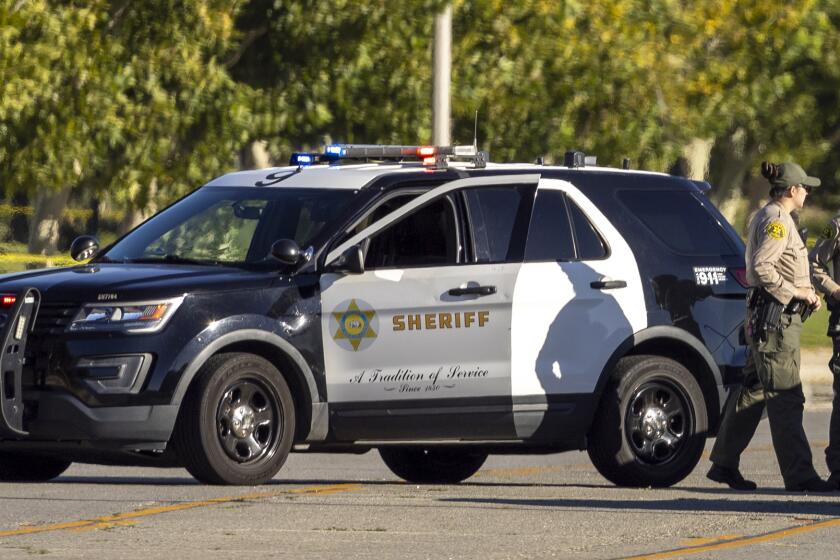Holocaust Tale for Kids
- Share via
How do you teach children about the Holocaust? And why should you spend precious leisure time taking a happy kid with bright eyes, a winning smile and a milk mustache to an exhibit that teaches about one of the greatest atrocities in human history?
I wasn’t sure how to answer these questions until I went to see the interactive exhibit “Remember the Children--Daniel’s Story,” which, thanks to the outreach program of the U.S. Holocaust Memorial Museum, has just begun a four-year road trip to five cities. This exhibit, which has been acclaimed by parents and historians--and, more important, by children--opened Tuesday at the California Science Center.
Daniel’s story is meant for children over 8. Both Daniel and his family are composite characters, drawn from archival sources. With the pages of Daniel’s diary providing the narrative thread, the viewer moves through the various stages of this 9-year-old’s experiences--from his happy, active life in Germany through the claustrophobic squalor of the Lodz ghetto and, finally, to Auschwitz, which we know Daniel and his father survive.
The exhibit begins with a short film that reveals all of Daniel’s story, so that children will not be frightened by suspense. Then we walk down a tree-lined path in a small German town to Daniel’s home. We wander around its orderly bedroom, comfortable living room and welcoming kitchen. Inside, we hear the telephone ringing, the children playing outside.
As a voice reads from Daniel’s diary, we watch his world narrow as Nazi power grows. He can no longer go to school or swim in the city pool, and his friends will no longer play with him. By opening and closing windows, we see the street scene change. Yellow stars appear on coats; we hear anti-Semitic crowds rioting and breaking windows during the infamous Kristallnacht. His father’s shop is destroyed. We sit on a yellow park bench marked by the words “Only for Jews.”
Most haunting is the crowded room in which the family must live within the confines of the Lodz ghetto. The earlier kitchen had freshly baked cookies; their new home has one rotting turnip in a soup tureen. When we open the windows, we see changing scenes of squalor and poverty. Daniel’s younger sister now works as a seamstress in a factory; the family is barely surviving.
The exhibit is brilliantly designed, the words carefully chosen and the various rooms and scenes are aimed at the tender sensibilities of children. There are no piles of shoes or hair; there is no mention of crematories or the smell of smoke. Daniel “is sent away” rather than deported or transported in a cattle car.
The point of the exhibit is to live through these changes with Daniel, not to be horrified by the atrocities of the Holocaust. We not only hear and read Daniel’s diary, we also follow his journey, by opening and closing the suitcase that accompanies Daniel from home, to the Lodz ghetto and, finally, to the death camp.
At the end of the exhibit, children enter a room in which they are encouraged to express their thoughts and feelings on cards, which they can post on huge bulletin boards. Sherrie, blond and 10, opens the door, blinks in the bright light, sits down and hastily writes on a card, “There is nothing wrong with being different” and pins it to a bulletin board.
I watch a 9-year-old boy from El Salvador post his message: “Daniel, I always knew the Holocaust was a terrible thing, but I never felt it until today--I am so sorry.” A 13-year-old African American girl writes, “We have to remember, if we don’t, who will?” A 12-year-old boy, son of Mexican American immigrants, sits down, his face pinched in concentration. “We’re all human; we have to get along, especially in this country where we are so different. Daniel, I’m going to do something so it doesn’t happen again--to ANYONE.”
My only criticism of the exhibit was that its list of non-Jewish victims included only Gypsies, the handicapped and “people who held different political beliefs.” Let us remember that some of those “people” included communists, leftists of all kinds, and gays and lesbians.
After I saw this exhibit in San Francisco, friends asked me, “Was it too frightening?” No, I answered truthfully. Though the exhibit makes the Holocaust come alive, it teaches but does not traumatize. “Should I take my kids?” Yes, take your children. Even borrow a child. Just don’t ignore this exceptional opportunity to teach a young person how bigotry, prejudice and hatred can unleash uncontrolled and monstrous atrocities.
Ruth Rosen, a professor of history at UC Davis, writes regularly on politics and culture.
BE THERE
“Remember the Children, Daniel’s Story,” California Science Center, 700 State Drive, Exposition Park, Los Angeles. Daily, 10 a.m. to 5 p.m. Ends Jan. 24. Free admission. Parking, $5.(213) 724-3623.
More to Read
Sign up for Essential California
The most important California stories and recommendations in your inbox every morning.
You may occasionally receive promotional content from the Los Angeles Times.













